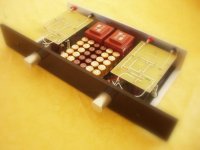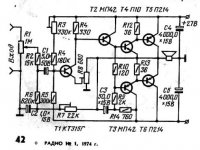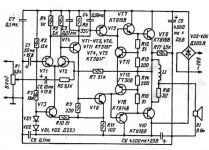Little Brother
Thorsten , TB,
AD149 germanium power device could be swaped for AD162 but transformer secondary must fall to 6V ( without any loss in musical quality but lesser power output ). Otherwise an "equivalent" ( ASZ 17 ... ) could theoretical do the same job ( ? ).
The +9V DC feed the output transistor via the bias resistor ( 220R )...
The 0 is on the AD162 collector himself linked to the loudspeaker minus...
Rock 🙂
Thorsten , TB,
AD149 germanium power device could be swaped for AD162 but transformer secondary must fall to 6V ( without any loss in musical quality but lesser power output ). Otherwise an "equivalent" ( ASZ 17 ... ) could theoretical do the same job ( ? ).
The +9V DC feed the output transistor via the bias resistor ( 220R )...
The 0 is on the AD162 collector himself linked to the loudspeaker minus...
Rock 🙂
Re: SCHEMATIC
What a lovely DC coupling Ge transistor power amplifier! I think you have a pair of high sensitivity speakers drived by it, is it right?😉
ROCKMANDRAKE said:Hi,
please note :
HEATSINK is compulsory...
Don't hesitate to use very best ( carbon, of course ) resistors ( Riken 'n' kiwame are my favourite )...
This amp offering a great combination of dynamic, rythm and transparency... Midrange and treble blends with an amazingly rich and plentiful bass... It's valve like 😉
regards
Rock
What a lovely DC coupling Ge transistor power amplifier! I think you have a pair of high sensitivity speakers drived by it, is it right?😉
Hi ROCKMANDRAKE !
The collector current from AD149 must go somewhere. So it flows through the loudspeaker voice coil, in order to return to the battery (zero ).
Thorsten
🙁
The collector current from AD149 must go somewhere. So it flows through the loudspeaker voice coil, in order to return to the battery (zero ).
Thorsten
🙁
"The collector current from AD149 must go somewhere. So it flows through the loudspeaker voice coil"
The coil needs the current in order for the speaker to move and produce sounds.
This design is interesting (only 7 components, no ICs), but is it the best from this perspective? Ideally one transistor would be enough. How close can one get to that with real ones, with say <1% distortions?
And do those 2 transistors need to be paired again, in order to minimise distortions?
The coil needs the current in order for the speaker to move and produce sounds.
This design is interesting (only 7 components, no ICs), but is it the best from this perspective? Ideally one transistor would be enough. How close can one get to that with real ones, with say <1% distortions?
And do those 2 transistors need to be paired again, in order to minimise distortions?
An output transformer maybe? Although any extra load will degrade even more the already poor class A efficiency.
I found a circuit with only 1 valve. That one does away with DC by wasting half of it, and using a capacity to revert the load current.
http://diyaudioprojects.com/Solid/ZCA/ZCA.htm
I found a circuit with only 1 valve. That one does away with DC by wasting half of it, and using a capacity to revert the load current.
http://diyaudioprojects.com/Solid/ZCA/ZCA.htm
Hello ROCKMANDRAKE,
I was able to get both types of transistors from Europe. So, I am getting closer to build the "little brother'. I see on the last picture posted by you added pots. You have also mentioned 'improved version'. Did you do any changes to the circuit? What is the value of the pots?
I was able to get both types of transistors from Europe. So, I am getting closer to build the "little brother'. I see on the last picture posted by you added pots. You have also mentioned 'improved version'. Did you do any changes to the circuit? What is the value of the pots?
Littl'B
Hi,
here is the "improved version" schematic...
Actual power output : 1.5w
Sonic signature is gorgeous but despite all my efforts DC is still present ( +/- 350 millivolts ) in the loudspeaker output ( but no hum, no noise with my small RSL Horn - 95db efficiency )
Rock 😉
Hi,
here is the "improved version" schematic...
Actual power output : 1.5w
Sonic signature is gorgeous but despite all my efforts DC is still present ( +/- 350 millivolts ) in the loudspeaker output ( but no hum, no noise with my small RSL Horn - 95db efficiency )
Rock 😉
Hello Rock,
ohh welll, your answer for my question is very..........mysterious😉
Have you got schematic of improved version of your amp?
In reference to your information about DC offset present at the output. What is a save DC offset? I want to use your amp with single-drive home made speakers with approximate sensitivity of 92dB. But, I would also like to try it with my PSB Alphas. Can this DC value hurt them?
Thanks
ohh welll, your answer for my question is very..........mysterious😉
Have you got schematic of improved version of your amp?
In reference to your information about DC offset present at the output. What is a save DC offset? I want to use your amp with single-drive home made speakers with approximate sensitivity of 92dB. But, I would also like to try it with my PSB Alphas. Can this DC value hurt them?
Thanks
Hi!
This very interesting circuit _current_ amplifier on germanium transistors from old russian magazine (Radio).
R8 - provide minimum voltage amlification, R7 - regulate positive feedback. This autobalanced circuit. Speaker connected in bridge from output transistors\filter capacitors for minimized dynamic resistance. More transistors in common collector circuit use.
Pout approx. 10W.
Is really fine circuit. Taste it!
This very interesting circuit _current_ amplifier on germanium transistors from old russian magazine (Radio).
R8 - provide minimum voltage amlification, R7 - regulate positive feedback. This autobalanced circuit. Speaker connected in bridge from output transistors\filter capacitors for minimized dynamic resistance. More transistors in common collector circuit use.
Pout approx. 10W.
Is really fine circuit. Taste it!
Attachments
Russian alternative
Dear Alp,
superb idea !! I am interested in all germanium power amplifier design ...
Thanks
Rock
Dear Alp,
superb idea !! I am interested in all germanium power amplifier design ...
Thanks
Rock
- Home
- Amplifiers
- Solid State
- My beloved amp



